Posted on April 14, 2022
With Easter on the horizon, we're taking a look at perhaps the most famous biblical film of all time, Cecil B. DeMille's THE TEN COMMANDMENTS. Sitting at an unbelievable runtime of 3 hours and 40 minutes and featuring an excess of Charlton Heston, you may know this film as a staple of the Catholic curriculum. As anyone who sat through the masterpiece in childhood will tell you, this film is best enjoyed sitting criss-cross applesauce on a racecar carpet, sipping Welch's grape juice out of a Dixie cup and nibbling carefully rationed pieces of pita bread.
However, this movie is not just an Easter classic; it's actually a very significant piece of film history. Pulling off mammoth feats of filmmaking, groundbreaking advances in special effects and starring an all-star cast, there's a good reason this film has stuck around for over 50 years.
Many are already familiar with the story of Moses that is told in the film. What you might not know is that the making of this film was a raucously chaotic, circus of a production second only in buffoonery to 1981's ROAR. Allow us to tell you the tale, as we break down the most hectic and triumphant moments from the production of God's favourite movie, THE TEN COMMANDMENTS.
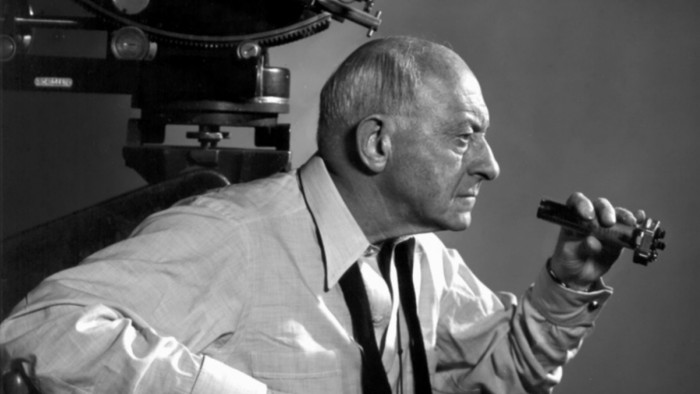 CECIL B. DEMILLE IN GENERAL
CECIL B. DEMILLE IN GENERAL
For those of you not familiar with one of Hollywood's founding fathers, Cecil B. DeMille arrived in La La Land sometime in 1913 to make motion pictures with the help of his friend Samuel Goldwyn who literally put the G in MGM. DeMille found success early in his career, making the first film ever to make a million dollars and pioneering the big-budget epic. To give you a sense of his temperament, the image of the director in the high chair with the megaphone and cap, sitting omnipotently, was based entirely on DeMille. The man was the first director to use a boom mic for chrissake. He was a very powerful and intimidating person who demanded perfection from every actor, extra and crew member and yet, he is responsible for much of the hijinx that ensued during the making of THE TEN COMMANDMENTS.

RESEARCH, RESEARCH, RESEARCH
Known for blowing the budget, DeMille spent the majority of his time in pre-production which he called " the cheapest part of making a movie." As it is written in the Bible, the ten commandments story is missing a solid 30 years of Moses' life, years that DeMille had to uncover through HUNDREDS of hours of research with a team of screenwriters and research assistants. This included rifling through the Old Testament incessantly as well as pulling from secondary accounts written hundreds of years after Moses's passing. The screenplay came together alongside the storyboards which were meticulously done in watercolour by DeMille's associate director Henry Wilcoxon who also acted in the film as Pentaur. These watercolours were essential and were eventually followed almost exactly during the filming in Egypt. This process worked every time for DeMille who insisted that all of his movies were "made on the desk."

MICHELANGELO'S DOPPLEGANGER
The line was out the door when auditions opened for the role of Moses and the team were going crazy; auditioning actor, after actor. CB was outside the studio smoking and discussing the casting with a team of guys when Charlton Heston drove by in a convertible with the top down and winked at CB. The director turned to his secretary, demanding to know who this actor was. His secretary then read out Heston's resume, to which DeMille replied "I liked the way he looked just now. Bring him in for the circus picture." This turned out to be the 1953 Best Picture Winner, THE GREATEST SHOW ON EARTH. Sometime after starring in GREATEST SHOW, Heston noticeably broke his nose. So, when DeMille came across a photo of Michelangelo's sculpture of the Moses, he noticed a striking resemblance; the brows, the cheeks and that nose. Heston was offered the job right away and he eagerly accepted.
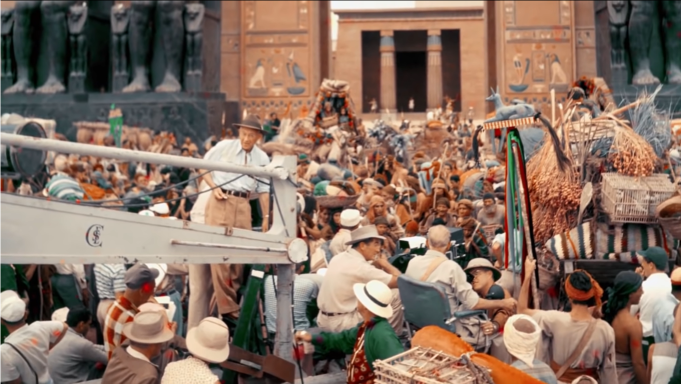
IF WE BUILD IT, THEY WILL COME
It had always been a dream of DeMille's to shoot in Egypt, to stand where the Moses stood. However, it was of course cheaper to shoot in the Santa Maria Valley in California, which looked nearly identical on film. But, never one to let budget keep him down, DeMille said screw it, put his family on an ocean liner and set up shop in Egypt. One look at the set in the desert will make it very clear why this was the most expensive movie ever made in its day. Set designers had rebuilt Ancient Egypt to the T, with walls that soared into the sky and Sphinxes that stood 20 metres tall. Just behind these walls were stables upon stables for the several hundred camels and horses, a sprawling commissary, the luxurious costume department, the trailers, the props department, you name it. DeMille basically rebuilt paramount at Mount Sinai.
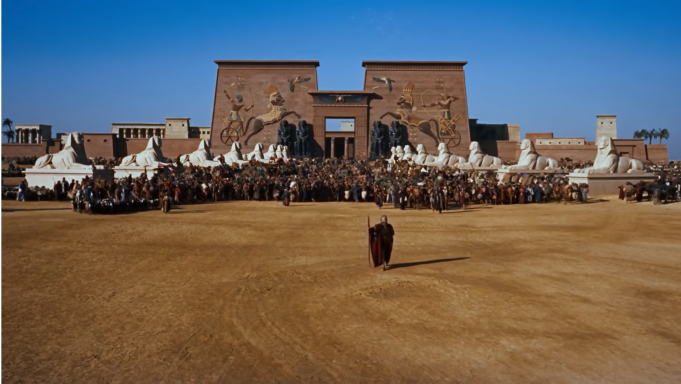
LET MY PEOPLE GO
The shooting of the infamous Exodus scene epitomized the chaos of making this film. The scene featured tens of thousands of extras who needed to be fed, hundreds of camels and horses each with an attendant, who all needed to hit their marks. The production was so unprecedentedly humongous that DeMille couldn't even call action. Instead, he had to start the scene by shooting a gun into the air because it was the only way for everyone, including the animals, to hear him.
Filming this scene in the Egyptian heat, eventually proved too much for DeMille's 73-year-old body and he gave in to a heart attack in the middle of shooting. After being attended to in a local hospital, he was told to stop directing immediately. DeMille said he'd rather be dead than not make this film and was back on set the next day.
The extras, it seems, were not so eager to keep making the film. After three days of shooting the Golden Calf scene in which people are engaging in drinking, prostitution and all other kinds of depravity, the extras grew exhausted. As Charlton Heston tells it, on the third day one of the women had the gall to go up to DeMille and ask "Who do I have to screw to get off this picture?!"
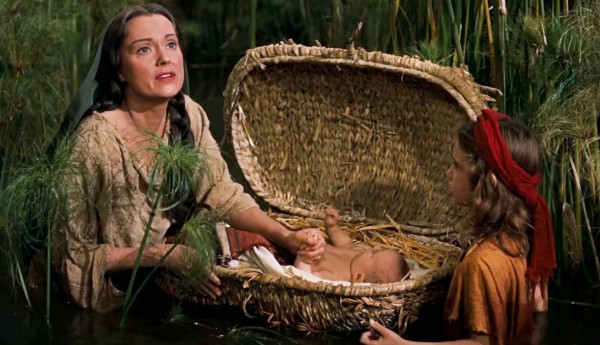
HE'S GOT THE PART!
When Heston was told he had to move to Egypt to do the film, his wife had to stay behind as she was several months pregnant. Charlton flew back home upon hearing that his wife was nearing her due date. DeMille, businessman that he was, couldn't help but see a business opportunity. Just as Heston reached down to hold his newborn son, a nurse came into the room with a telegram. It was from CB DeMille, simply reading "Congratulations! He's got the part." It turns out DeMille had planted someone at the hospital where Heston's wife was having their child to tell him whether the child was born a boy, so he could cast him as baby Moses in the Nile river scene. Heston's son was on set two months later being scooped out of a basket by the Pharaoh's daughter.
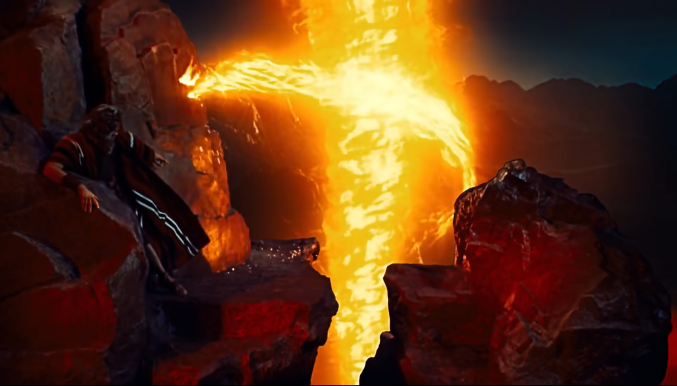
SPECIAL EFFECTS
It took Paramount's entire team of editors 14 months in post-production, working 16-hour days, seven days a week to cut this movie together. The notoriously fake fire in the movie was actually hand-drawn and then animated by overlaying separate pieces of film. This was the idea of William Sapp, the special effects coordinator.
Sapp was also tasked with making the 12 plagues come to life. In the instance of turning the Nile red, Sapp submerged himself underneath the pool that was serving as the Nile in the palace. Every take, Sapp would go underwater holding a hose and when Moses dipped his staff in the water, he would turn the hose on and red dye would turn the pool crimson.
Similar practical ingenuity was needed in the scene where God carves the stone tablets with his commandments in fire. for this shot, Sapp carved the tables from the back, filling in the divots of the letters with gunpowder, which he would then light with a match, resulting in a stunningly vibrant effect that really made the climax of the movie.
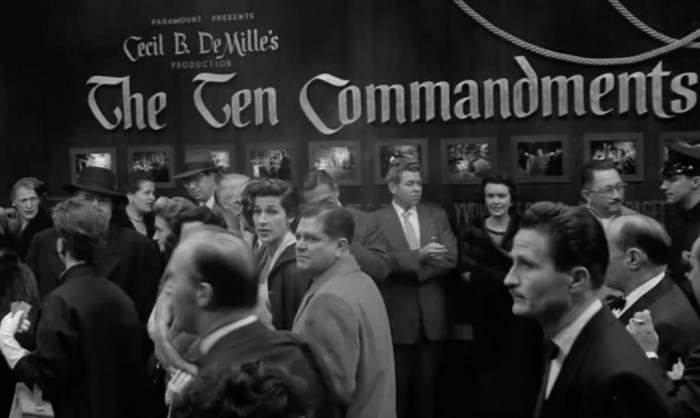
EGYPTIAN REDEMPTION
By the late 1950s, Cecil's standing with the critics was low. He a been around a very long time, meaning a lot of people saw his mode of filmmaking as antiquated. Additionally, he had made a lot of money with his movies, something that, to this day makes critics shy away from supporting a film. Despite all of this, THE TEN COMMANDMENTS ended up being worth every bit of heatstroke giving, heart-attack-inducing, bank-breaking grief when it became the most internationally successful film ever made in Hollywood. The film was an instant classic, grossing 64 million dollars at the box office, more than covering its 13.2 million dollar budget. When all was said and done, Cecil B. DeMille took 10% of his own share in the movie and divided it between 100 crewmembers, paying out hundreds and hundreds of thousands of dollars. COMMANDMENTS was nominated for seven Oscars that year, taking home one for Best Special Effects.
The story of Moses is a timeless one. He was a hero whose spirituality crosses 3 religions, something almost no other prophet can claim. It is no surprise that a film about him would be destined for greatness. For many this is the film that made God feel real. Truly a labour of love, this Easter classic lives on in the minds of men forever and will always stand as a testament (no pun intended) to the effect great films can have on the human spirit. Make sure to tell your kids that before they run off to fail their Religion 8 exams, grape juice in hand.
Back to blog listing